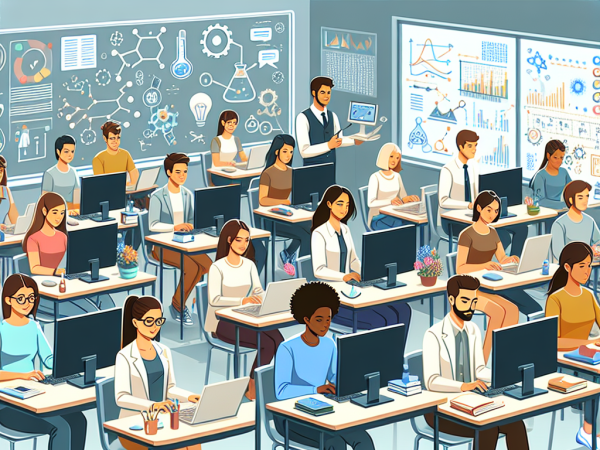Artificial intelligence has been a buzzword for the last few years. From funny videos on YouTube to Congressional hearings about regulations regarding its use, AI has felt like yet another fad the greater public has become infatuated with. However, the greater question many of us are asking ourselves is, “How does AI impact me?” Countless stories have been published about AI being this immensely powerful tool, while others view it as a threat to their well-being, from their jobs to the planet’s survival. As someone relatively new to using AI, I decided to do my part in trying to understand the complexities of it.
See AI, Hear AI, Do AI
One of the first ways I interacted with AI was through the GenAI cohort. Here we were tasked with finding a way to leverage AI in our daily work. Initially, it felt pretty daunting to find a purpose for a tool I knew very little about nor how to use. The best way I could equate it is telling someone to Google search for anything in the early days of the Internet. Where does one even begin? To help with this process, I first tested out what GenAI was capable of with a personal project of mine. I tasked U-M GPT with generating a script for a board game I have worked on for a couple years and was beyond impressed with the character names, voice lines, etc. it created. The more prompts I typed, the more impressed I became. This made me take a step further by looking into other AI tools, and eventually, I came across an excellent text-to-speech software. The combination of these voice lines being brought to life with an AI voiceover allowed me to accomplish a major obstacle I hadn’t previously been able to overcome. In addition, the AI text-to-speech software is now a tool I use daily when creating tutorial videos for ITS. Editing the narration for videos and courses went from a multi-hour process to making changes in a matter of minutes. Upon first impressions, GenAI was definitely living up to the hype.

Using AI to Build AI
After participating in the GenAI cohort, I was approached by Jennifer Wilkerson and Keila Walton from the Emerging Technologies team about creating micro-learning courses about AI. Our goals were to make generative AI more approachable for new users as well as showcase the many new tools offered at the University of Michigan. As I began designing the courses, I focused on making sure we all are aware of AI’s presence in our daily lives. For example, did you know that 44% of Americans don’t realize they use AI regularly? These systems have become ingrained in our technology, and often we don’t think of them as AI. Spellcheck, email filters, music and video recommendations are a few that come to mind. As I continued designing these courses, I made use of the AI tools at my disposal. From generating stock images to using ElevenLabs to narrate an activity to generating practice prompts, AI literally helped me build these courses about itself.
AI is Tool, Not Your Competition
Before I go any further, I first want to acknowledge people’s concerns about generative AI impacting their work. Often when a new technology is introduced, it can be intimidating to approach or feel as though you are being left-behind on the technology wave. For this reason, I want to assure you that GenAI is not here to replace your job; however, knowing how to use it is becoming increasingly more important. Similar to email or Microsoft Office or Zoom, generative AI tools can help you accomplish specific tasks in less time. When designing these courses, I didn’t simply type “Design three courses about AI” and presto, the job was done. Generative AI’s role is to help you build the first 70-80% of your idea; you are responsible for the remaining 20-30%. People who struggle with creativity will use generative AI to formulate an idea they can work with while those on the opposite end of that spectrum will use it to bring their ideas to life. The point I’m trying to make is that we don’t hand over all creative liberties to generative AI. GenAI can give you ideas of what type of pottery to create, what materials you’ll need, and how to do it, but at the end of the day you are the sculptor.

Final Takeaways
As you progress on your own journey with GenAI, here are a few things I would like to leave you with:
- Read both positive and negative articles – Many of us find ourselves on one-side or the other in the AI debate. There are very real concerns and benefits AI has to offer. From Khanmigo helping students learn math skills without giving them the answers to the dangers of misinformation and bias, I learned a lot by taking the time to learn more about how AI is impacting our reality.
- Lots of learning opportunities – The University of Michigan has a plethora of AI tools and courses available at your fingertips. ITS Teaching and Learning offers a wide range of workshops and on-demand videos about generative AI. You can also take the courses I designed on My LINC by searching for GENAI. These courses can typically be taken in 15-30 minutes to help you get started. LinkedIn Learning and Michigan Online also have phenomenal courses you can take. You can check out other ITS AI Resources here.
- Don’t force it – Sometimes, unnecessary pressure is placed on employees to immediately find a use for new technology. As a former middle school teacher, I often draw inspiration from my life outside of work. I largely attribute my current use of GenAI to experimenting with prompts for my board game. Test U-M GPT with basic tasks like writing an email draft, proofreading a message, or creating a music playlist to listen to. Eventually, you’ll find what works for you and feel like a genius!

Great article!!
Nice one — I appreciate the pottery analogy. Keep up the good work!
What a thoughtful article! Thanks for sharing!